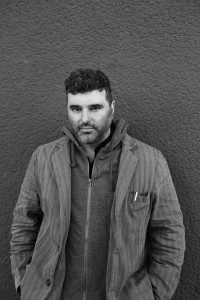“BAROQUE-MIDDLE-EASTERN-CYBERPUNK”
John Kameel Farah is a Canadian composer and pianist whose work embraces aspects of Baroque and Early music, Improvisation, Middle-Eastern music and forms of Electronic music.
Born near Toronto in 1973 to Palestinian parents, he studied composition and piano at the University of Toronto, where he received the Glenn Gould Composition Award twice during his studies. In 1999 he had private lessons with Terry Riley in California, and later at the Arabic Music Retreat in Hartford. He composes for ensembles, dance and film, but largely focuses on live solo concerts, using a setup which surrounds the piano with synthesizers, as well as processing the piano through computer filters and effects, referring to his approach as “Baroque-Mid-Eastern-Cyberpunk”.
He occasionally presents his side-project, “Music for Organ and Synthesizers”, looping and altering the pipe organ’s sound in combination with analog and digital synths in various churches and cathedrals throughout Canada and Europe.
Collaborations have included several scores for iconic Canadian choreographer Peggy Baker, and rising ballet star Robert Binet. He has also worked with astrophysicist John Dubinski, composing soundtracks to animations of galaxy formations and collisions in a project called “Gravitas”. In 2010 he became a member of the Canadian Electronic Ensemble, the oldest continuously active live-electronic performing group in the world. In Berlin, he frequently works with the Oriel String Quartet and the early vocal ensemble Vox Nostra. In 2016 he received a Dora Mavor Moore Award for sound design/composition for his work with Peggy Baker Dance Projects. In 2023 he was invited as guest artist to perform with the iconic electronic band Tangerine Dream in Toronto.
Also a visual artist, Farah creates intricate and detailed ink line-drawings. which draw inspiration from astronomy, sound waves, and Near-Eastern history and mythology. He has presented his artwork at solo and group exhibitions, sometimes featuring live projections of them during concerts.
Farah is based between his native Toronto, and Berlin. He regularly performs across Europe, and has toured throughout the U.K and North America, as well as South Korea, Brazil, Mexico, and Israel/Palestine. He has given concert-lectures at several universities in both Canada and Germany and has performed his work in some of Europe’s most prestigious venues, such as Berlin’s Volksbühne and Haus der Kulturen der Welt, the Kölner Philharmonie, Sadler’s Wells in London and the Elbphilharmonic in Hamburg, and most recently at the Berlin Philharmonic.
In 2023 John performed Bach’s complete Well-Tempered Clavier from memory in Berlin, connecting each key with improvisations and electronics. He is currently doing a composition residency with the National Arts Centre Orchestra in Ottawa, Canada, writing a new work for piano and orchestra to be premiered in 2025. In 2023 he was a recipient of the Johanna Metcalf Award for the Performing Arts, from the Metcalf Foundation and Ontario Arts Council.
“Watching Farah live, one can’t help but suspect they are watching a musical genius at play. The experimental pianist and composer performs with an almost rapturous physicality, attacking his instruments with astonishing speed and virtuosic precision.” -Toronto Star, 2024
(More press quotes here.)

photo: Leonie Hochrein